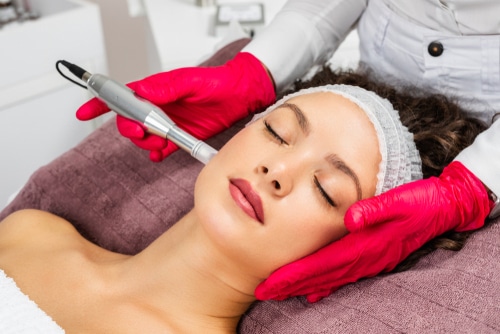The simple answer is yes, but what exactly is micro-needling, and what can this magical treatment do for your skin? In plain terms, micro-needling consists of a device embedded with tiny needles that penetrate the skin to create micro-injuries that trigger the skin’s natural wound healing mechanisms. It might sound crazy to suggest inserting needles of any kind or size into your face can produce favorable aesthetic outcomes; but it turns out it does, and as you may have already guessed; it is based on science. This process of creating tiny injuries improves cellular communication leading to optimal cell function, epidermal preservation, and strengthening of the dermo-epidermal junction. Due to the inflammation created, the synthesis of growth factors is increased, leading to an increase in collagen and elastin. The vascular endothelial growth factor is just one of the growth factors stimulated and responsible for angiogenesis. This leads to the generation of new blood vessels in the area being treated and an increase in the delivery of nutrients. So, what exactly does this all mean for the outcome of your treatment? It means that collagen and elastin will be significantly increased, resulting in a firmer, smoother appearance of the treatment area.
What can the addition of solutions do for my skin?
Collagen Induction Therapy has aesthetic benefits, but another benefit of micro-needling is the formation of microchannels that aid in the transepidermal absorption of chosen ingredients for your skin. Studies have shown that these channels will stay open for ten minutes following a micro-needling session, so applying a gliding solution full of additional skin-enhancing ingredients is imperative. Active ingredients may include Platelet Rich Plasma, which contains growth factors and cytokines. Activated platelets will increase the production of fibroblasts, resulting in collagen deposition. Collagen is a protein that helps strengthen the skin, resulting in a smoother, firmer skin appearance. As we age, collagen production naturally decreases. Microneedling is just one of the many ways to increase collagen production. Stay tuned for an upcoming blog about collagen and getting more! Microneedling is often referred to as Collagen Induction Therapy.
Other active ingredients used during your treatment are a hydrating solution containing Hyaluronic Acid, Organic Silicone, and Panthenol. This is our basic hydrating solution but trust me; there is nothing basic about it. Hyaluronic acid has a moisturizing effect and works by attracting water molecules to the outer layer of your skin. Organic silicon has a hydrating effect by helping the tissue maintain water levels. It also protects and reinforces collagen and elastin fibers. It improves the regenerative process and normalizes how the cells are metabolized in aging tissue. It also has an anti-inflammatory action that helps to reduce redness. Panthenol helps to hydrate, moisturize, and deeply condition the skin.
Many other solutions can decrease pigmentation and scaring and brighten lackluster skin. These customized solutions can stimulate fibroblasts, therefore, helping to reduce the appearance of wrinkles and skin flaccidity. During your micro-needling consult, the best formulation will be chosen based on your history and skin care needs.
What conditions can Microneedling treat?
There are various indications for micro-needling. Microneedling can help treat wrinkles, scarring, stretch marks, and scars and aid skin rejuvenation. It can also improve melasma and even improve certain types of Alopecia. Certain scars respond better to micro-needling treatment, and the type of scars treated should be identified and evaluated during your consultation. According to Singh A, Yadav S., The types of Acne scars best suited for treatment include “atrophic, boxcar, rolling, and ice-pick scars. Though deep boxcar scars, ice-pick scars, and linear scars are less likely to respond.” (Yadav and Singh) Other scars suitable for micro-needling treatment include burns, trauma, hypertrophic, and scars caused by chicken pox.
Who should avoid micro-needling treatments?
Certain conditions do not respond well and can worsen if the area is treated with micro-needling. Patients experiencing an active acne outbreak, especially inflammatory, should wait until the acne is healed. Acne scars, however, can respond well to treatment. Active Herpes, warts, or other infectious skin conditions must also be avoided. It is advised if a patient does not have current lesions but has a history of Herpes Labialis that they receive antiviral treatment before and after micro-needling to avoid an outbreak. Eczema and Psoriasis at the site of treatment should also be avoided. Patients with a history of easily experiencing Keloidal type scaring should also avoid micro-needling treatments as they could potentially experience a negative outcome. Patients immunosuppressed or actively receiving chemotherapy should avoid micro-needling as they are at an increased risk of experiencing skin infection. You should get neurotoxin injections on a different day and wait at least two weeks after receiving injections to avoid spreading the neurotoxin to unwanted treatment areas.
What can I expect on the day of treatment?
When you arrive, a numbing cream may be applied to prevent discomfort to your skin. If a depth of 0.5mm is used, numbing cream should not be required but is still available if desired. The depth of your treatment will be determined in your consultation. The treatment itself only takes about 15 minutes to complete. Your face will be cleansed with an antibacterial cleanser, and numbing cream will be removed if used. During the treatment, you may feel a scratching sensation and feel like you have a mild sunburn afterward. Topical solutions will be applied throughout your treatment to help the device glide and deliver selected solutions via the microchannels created during micro-needling. After the treatment is completed, additional serums will be applied, and a quality sunscreen will be provided. Immediately after treatment, your skin may experience some erythema, AKA redness, and slight swelling that will dissipate over the next day. It is possible but rare to experience bruising after treatment. Arnica can be applied over the next couple of days if you experience or are prone to bruising.
What is the bottom line?
Microneedling is an ideal treatment option for patients not wanting to undergo plastic surgery and offers a more natural, rejuvenated approach to turning back the hands of time. Clinical studies have shown that “There is no downtime, and the patient can resume daily work the next day. Treatments are performed at 3–8 week intervals, and multiple sittings are needed to achieve the desired effect on the skin. The final results cannot be viewed immediately because new collagen continues to be laid down for approximately 3–6 months after treatment has ceased.” (Yadav and Singh) What does this last statement tell you? Microneedling is an incredible addition to your skin care regimen that will continue to offer benefits months after your treatment! Collagen is the building block for tighter, smoother, healthier looking, and feeling skin. Many peer-reviewed research articles are available to further educate you on your journey to decide if this is the treatment for you. On a personal note, this is a treatment I regularly use, and I recommend it to most of my clients looking to obtain the skin care results they want. This treatment is ideal for any age and with little to no downtime.
Yadav, Savita, and Aashim Singh. “Microneedling: Advances and Widening Horizons.” Indian Dermatology Online Journal, vol. 7, no. 4, 2016, p. 244, www.ncbi.nlm.nih.gov/pmc/articles/PMC4976400/, 10.4103/2229-5178.185468.

